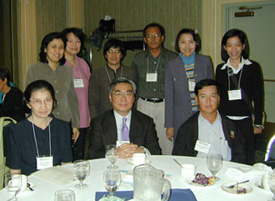Schools
PEASE Academy: The Restorative Recovery School
- Details
Nancy Riestenberg is a prevention specialist with the Minnesota (USA) Department of Education’s Safe and Healthy Learners Unit. She presents workshops on bullying prevention, restorative practices in schools and school climate.
In a recovery school, the students commit to working on recovery from chemical dependency and addiction while becoming successful students. Since all of the students attending the school have been in chemical dependency treatment, the safety of the environment is the first concern of students, their families and staff. Applying restorative principles and the process of the circle has helped one recovery school create a truly respectful, student-centered program.
PEASE Academy (“Peers Enjoying A Sober Education”), located in a church in Minneapolis, Minnesota, was the first
...Restorative Practices at Queanbeyan South, an Australian Primary School
- Details
| Queanbeyan South Public School is a 2004 winner of an Australian Crime and Violence Prevention Award, sponsored by the governments of Australia and New Zealand, for “Real Justice in a Safe and Happy School.” |
Restorative practices have proved a success at a primary school in Australia, where teachers have discovered that discipline works much better when the children themselves take part in the process.
A few years ago, Queanbeyan South Public School, in New South Wales, just outside the Australian capital of Canberra, was struggling with persistent
...The Nanaimo Community Justice Forum: A Restorative Justice Partnership in British Columbia, Canada
- Details
| The community justice forum model is used across Canada, part of a wider national restorative justice initiative. Restorative justice processes were influenced by North American Aboriginal and other traditional justice practices, in which everyone sits in a circle and speaks in turn, to resolve an issue affecting the community. The RCMP community justice forum resource guide can be viewed here. |
The Nanaimo Community Justice Forum (CJF), in the city of Nanaimo, British Columbia, Canada, is a fine example of how
...Follow-Up Research Confirms Positive Effect of a Restorative Milieu on Young Offenders
- Details
Click here to view the original findings for 1999-2001.
Paper presented at the annual meeting of the American Society
of Criminology, Nashville, Tennessee, November 16-19, 2004.
The IIRP gratefully acknowledges the assistance of the juvenile probation departments of Northampton, Bucks, Montgomery and Lehigh counties, Pennsylvania, for providing access to court data used in this analysis.
The Community Service Foundation and Buxmont Academy operate eight school-day treatment programs, 16
Restorative Justice Conferencing with Young Offenders at Brookside Youth Centre and Secondary School, Cobourg, Ontario, Canada: Interview with Michael Maguire, Bruce Schenk and Ron Cameron
- Details
Brookside Youth Centre, in Cobourg, Ontario, Canada, about 70 kilometers east of Toronto, is a secure residential facility and secondary school for young men who have come into conflict with the law, capacity 106. Brookside is using the Real Justice (an IIRP program) model of restorative justice conferencing. Below are excerpts from an interview with Brookside staff members Michael Maguire, superintendent of administration and programs; Bruce Schenk, chaplain and co-coordinator of the restorative justice program; and Ron Cameron, principal of the secondary school. The interview was conducted at “Building a Global Alliance for Restorative Practices and Family Empowerment, Part Two,” the IIRP's Fifth International Conference on Conferencing, Circles and Other Restorative Practices, August 2004, in Vancouver, British Columbia,
...Restorative Practices at Community Prep High School in New York City
- Details
(A letter from Community Prep co-leaders Ana Bermúdez and Mark Ryan is available here.)
The International Institute for Restorative Practices (IIRP), via its SaferSanerSchools program, is providing training and consulting at Community Prep High School, a public school in New York City for young people just out of juvenile detention. These are the kind of kids who are typically stigmatized as "tough" or "incorrigible" and written off. The story of how the IIRP and Community Prep's staff collaborated to implement restorative practices at this remarkable school was reported in The New York Times.
"Each year, as many as 8,000 New York City students,
...Report on the Fifth International Conference on Conferencing, Circles and other Restorative Practices
- Details
The IIRP's fifth international conference, "Building a Global Alliance for Restorative Practices and Family Empowerment, Part 2," in Vancouver, British Columbia, Canada, was a tremendous success, thanks to the many dedicated participants who journeyed from far and wide to contribute their wisdom and experience to the event. A delegation from the Thailand Ministry of Justice, including Kittapong Kittayarak, director general of the Department of Probation (seated middle), and Wanchai
A delegation from the Thailand Ministry of Justice, including Kittapong Kittayarak, director general of the Department of Probation (seated middle), and Wanchai
In Pursuit of Paradigm: A Theory of Restorative Justice
- Details
Paper presented at the XIII World Congress of Criminology,
10-15 August 2003, Rio de Janeiro.
Restorative justice is a new way of looking at criminal justice that focuses on repairing the harm done to people and relationships rather than on punishing offenders. Originating in the 1970s as mediation between victims and offenders, in the 1990s restorative justice broadened to include communities of care as well, with victims’ and offenders’ families and friends participating in collaborative processes called “conferences” and “circles.” This new focus on healing and the related empowerment of those affected by a crime seems to
...